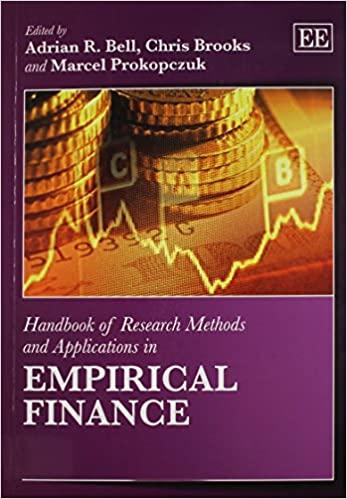Question
You may wish to avail of the website: http://www.bloomberg.com/markets/rates-bonds/government-bonds/** in the above address, insert ** = us, uk, germany, australia, or japan ] PART 1
You may wish to avail of the website:
http://www.bloomberg.com/markets/rates-bonds/government-bonds/**
in the above address, insert ** = us, uk, germany, australia, or japan ]
PART 1
EXAMPLE:
Suppose, we have a 2-year Treasury bill with yield to maturity (YTM) as above = 6%,
and a 5-year Treasury bill with coupon rate = 5% trading at $100. We can say:
$100 =
which confirms the 5-year yield to maturity = 5%.
To calculate the yield to maturity YTM3/5 that the market is imposing over years 3 to 5, we would solve:
$100 =
which with a scientific calculator, determine YTM3/5 = 4.25%.
However, on this particular website, we are not given the price of the bonds or the coupon rates, only the redemption yield over a 2-year and a 5-year period We need therefore to approximate YTM3/5 from:
(1.06)2(1+ YTM3/5)3 = (1.05)5,
which is to say, from: (1+ YTM3/5)3 = ,
YTM3/5 = - 1 = 4.34%.
which compares with the more accurate determination of 4.25% (above).
Now over to you to try this one:
Suppose we have a 2-year Treasury bill with yield to maturity (YTM) = 2%,
and a 5-year Treasury bill with coupon rate = 2.5% trading at $97.71. We can say:
$97.71 =
which confirms the 5-year yield to maturity = 3%.
To calculate the yield to maturity YTM3/5 that the market is imposing over years 3 to 5, we would solve:
$97.71 =
which with a scientific calculator, determine YTM3/5 = 3.715%.
However, when we are not given the price of the bonds or the coupon rates, only the redemption yield over a 2-year and a 5-year period, we must approximate YTM3/5 from:
(1.02)2(1+ YTM3/5)3 = (1.03)5,
Required:
Complete the above calculation for your estimate YTM3/5 for the rate that the market is imposing over years 3 to 5 and compare your answer with the more accurate answer above.
PART 2
Now over to you to interrogate the yields to maturity (redemption yields) for the countries of your choice (over the periods for which you have data). You may wish to avail of the website:
http://www.bloomberg.com/markets/rates-bonds/government-bonds/**
in the above address, insert ** = us, uk, germany, australia, or japan ]
If you have yields to maturity for years 1, 5, 20, and 30 year bonds, for example, you will calculate the yield to maturity (i) for 1 year, (ii) averaged over 2-5 years, (iii) averaged over 6 20 years, and (iv) averaged over 21-30 years.
PART 3
Avail of the internet or other source to estimate the current rate of inflation in the countries of your choice. Use this rate to estimate the current real rate of interest in the countries of your choice.
PART 4
Estimate the markets predictions for inflation over the periods for which you have redemption yields for the Treasury bonds in the countries of your choice. Do you feel that you can safely assume that real rates of return are unlikely to change into the future?
PART 5
Comment on the differences in your results for the two countries you have chosen.
PART 6
In the light of your findings, comment on the excerpt below from The Economist:
Buttonwood Money Illusion 4-10 March 2017.
If there is one aspect of the current era sure to obsess the financial historians of tomorrow, it is the unprecedented low level of interest rates. Never before have deposit rates or bond yields been so depressed in nominal terms, with some governments even able to borrow at negative rates. It is taking a long time for investors to adjust their assumptions accordingly.
Real interest rates (ie, allowing for inflation) are also low. As measured by inflation- linked bonds, they are around minus 1 % in big rich economies.
PART 7
Introduce an article (such as the one above) from either the financial pages or from such as the Economist newspaper or from the Internet that comments on the prospects for interest rates and inflation. How do the observations of your chosen article reflect on your findings above?
PART 8
Comment on how you see the implications of your findings for the stock market.
Step by Step Solution
There are 3 Steps involved in it
Step: 1

Get Instant Access to Expert-Tailored Solutions
See step-by-step solutions with expert insights and AI powered tools for academic success
Step: 2

Step: 3

Ace Your Homework with AI
Get the answers you need in no time with our AI-driven, step-by-step assistance
Get Started


